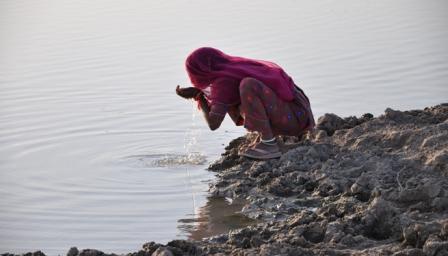During her yearlong stay, Tara trained at least twenty people into video production some of whom have succeeded in finding work in the local market as photographers, cameramen and wedding video makers. In this blog she gives a vivid account of the CVU, its producers and their work.
 To an outsider, the Thar Desert is as alluring as it is barren, bleak and hostile. And if you are here in the sweltering summer months, the inhospitable climate might make you want to never come back. But, if you decide to linger a little longer than you think you possibly can – stretching your tolerance for temperatures that threaten to touch 50 degree Celsius – and take that time to understand a little of what the desert is all about, then you might learn a thing or two about, who in my scope of understanding, are some of the world’s most thirsty people.
To an outsider, the Thar Desert is as alluring as it is barren, bleak and hostile. And if you are here in the sweltering summer months, the inhospitable climate might make you want to never come back. But, if you decide to linger a little longer than you think you possibly can – stretching your tolerance for temperatures that threaten to touch 50 degree Celsius – and take that time to understand a little of what the desert is all about, then you might learn a thing or two about, who in my scope of understanding, are some of the world’s most thirsty people.
Almost a year later, I’m still an outsider to this region, but my knowledge of this place and its people has grown proportionately to the time I have spent here. I joined Video Volunteers last October to begin work as a Video Trainer at the Community Video Unit at Jal Bhagirathi Foundation in Jodhpur, an NGO that works towards finding solutions to water problems in rural Marwar. The community video unit here had been set up in 2008 in collaboration with Video Volunteers and had trained at least twenty producers so far, some of whom had succeeded in attracting work in the local market as photographers, cameramen and wedding video makers. At the time I arrived here, there were five producers at Jal Bhagirathi’s CVU – three women and two men, who had recently completed their first film; a video magazine on the benefits of safe drinking water which they were in the process of screening in the many desert villages around Jodhpur.
The CVU at JBF was set up with the intention of generating awareness through community based media amongst some of the poorest and most remote people of the desert where JBF carries out its water and sanitation projects. In its beginnings, the CVU worked on subjects ranging from water conservation and sanitation, to gender and women’s education and JBF used these films or video magazines as they are called, to mobilise people who were or would be the direct recipients of their projects. In places where literacy is very low (48% in Marwar), the audio visual experience of films is an easy, effective and sometimes the fastest way to drive home a message. That is not to belittle other methods like the print form, awareness camps or even theatre, but at the same time one cannot under estimate the persuasive power of a good film, which when projected before a large gathering, will never be unsuccessful in stirring the minds of even the most illiterate and uneducated people.
Click here to read the entire article
The below video explains more about this activity
/articles/using-media-address-water-issue-rajasthan-video-volunteers